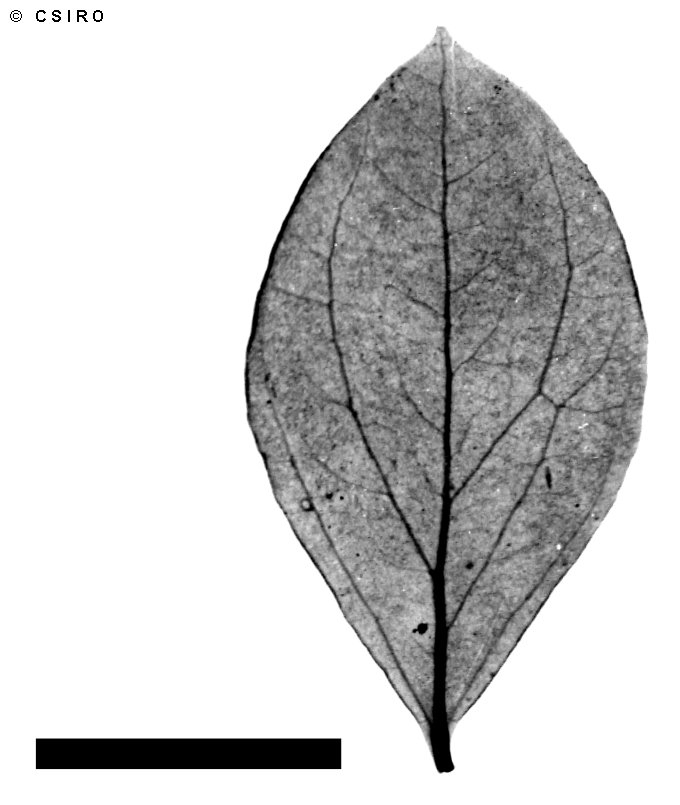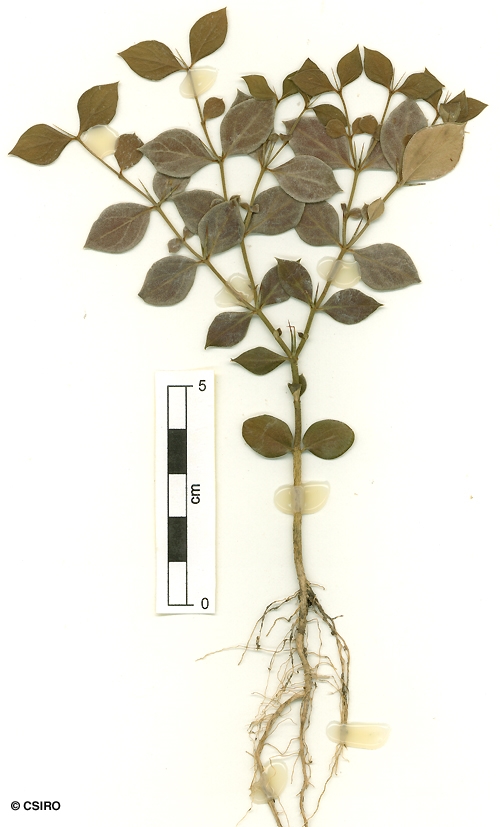Australian Tropical Rainforest Plants - Online edition
Carissa ovata R.Br.





Brown, R. (1810) Prodromus Florae Novae Hollandiae : 468. Type: Northern Australia, R. Brown.
Usually flowers and fruits as a shrub about 1-2 m tall but also grows as a vine. Vine stem diameters to 5 cm recorded. Very fine speckles usually visible in the blaze.
Twigs and petioles produce a milky exudate. Stipular spines straight (sometimes forked) about 6-25 mm long, usually present on most twigs between the points of attachment of the petioles. Leaf blades variable in size, about 5-55 x 4-40 mm, petioles up to 1-3 mm long. Small dark glands about 1 mm long usually visible on the twigs between the bases of the petioles. Lateral veins difficult to distinguish, about three or four on each side of the midrib.
Flowers about 4-5 mm diam. Outer surface of the calyx and corolla clothed in pale erect hairs. Sepals about 2.5-3 mm long. Corolla tube about 7-9 mm long, inner surface clothed in pale erect hairs, lobes about 2-4 mm long. Anthers about 1.6-1.8 x 0.5-0.6 mm, filaments about 0.1-0.2 mm long. Ovary hairy, at least towards the apex, lower style and stigma hairy. Stigma swollen but 2-lobed at the apex.
Fruits globose, about 10-22 x 7-14 mm. Flesh red. Seeds flat or slightly concave on one side with a central scar and convex or domed on the other. Testa finely reticulate on the outer surface. Cotyledons about as long as the radicle but much wider.
Cotyledons ovate or almost orbicular, about 10-12 x 9-10 mm, petiole short. First pair of leaves ovate to elliptic, usually smaller than the cotyledons, both the upper and lower surfaces of the leaf blade clothed in pale hairs, at least when young. At the tenth leaf stage: leaf blade elliptic, about 17 x 11 mm, apex acuminate, base cuneate, both the upper and lower surfaces sparsely clothed in short erect hairs. Stipular spines present. Seed germination time 13 to 31 days.
Occurs in WA, NT, NEQ, CEQ and southwards to northeastern New South Wales. Altitudinal range from near sea level to 900 m. Usually grows in open forest where it grows as a shrub but also found in monsoon forest where it can grow as a vine.
Suspected of being poisonous to stock but evidence is not conclusive. Everist (1974).
Food plant for the larval stages of the Common Crow Butterfly. Sankowsky & Neilsen (2000).
Food plant for the larval stages of the Australian Crow Butterfly. Common & Waterhouse (1981).
Leaf, stem and root material of this species was active against some tumors. Collins et al. (1990).





